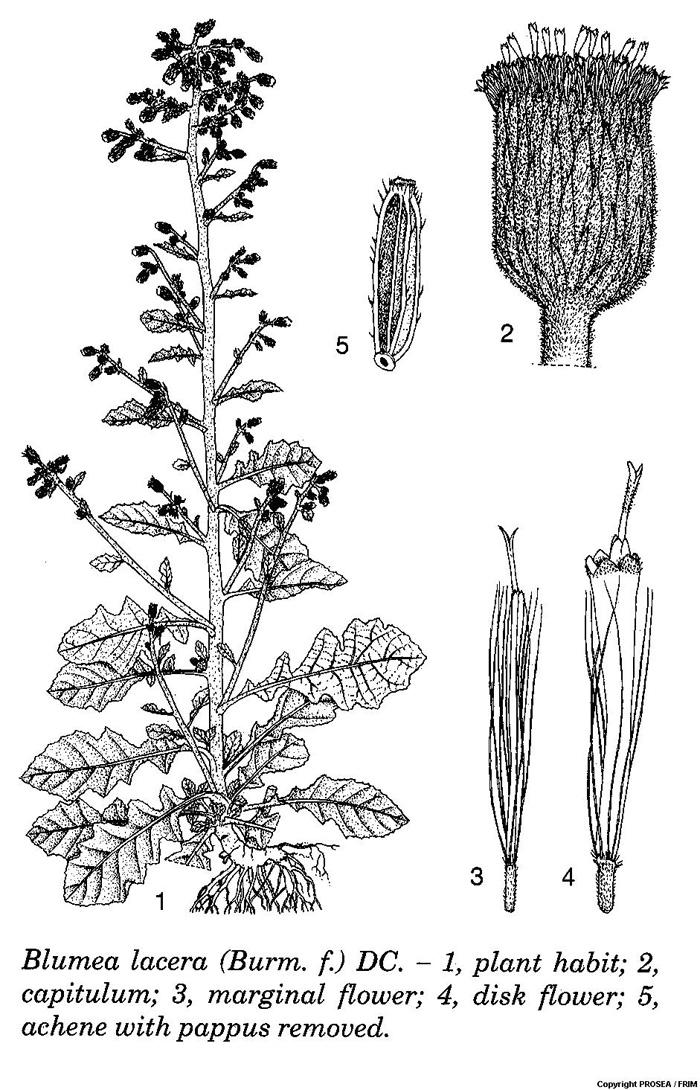Scientific Name
Blumea lacera (Burm.f.) DC.
Synonyms
Baccharis auriculata Wall. ex DC., Blumea acrocephala Miq., Blumea bodinieri Vaniot, Blumea cernua DC., Blumea cinerascens DC., Blumea commersonii Edgew., Blumea cuneifolia DC., Blumea dregeana DC., Blumea elongata DC., Blumea fontinalis Edgew., Blumea glandulosa DC., Blumea heyneana DC., Blumea hieraciifolia Hook.f. & Thomson, Blumea holosericea DC., Blumea hymenophylla DC., Blumea lactucifolia DC., Blumea musra DC., Blumea subcapitata DC., Blumea thyrsoidea Sch.Bip., Blumea trigona DC., Blumea velutina H.Lév. & Vaniot, Blumea villosa Sch.Bip. ex Hook.f., Conyza acrocephala Miq., Conyza amoena Link, Conyza dentata Blanco, Conyza hamiltonii Steud., Conyza lacera Burm.f., Conyza natans Buch.-Ham. ex Hook.f., Conyza necessaria Buch.-Ham. ex DC., Conyza thyrsoidea Pers., Conyza velutina (H.Lév. & Vaniot) H.Lév., Erigeron exstipulatus Schumach. & Thonn., Senecio velutinus H.Lév. & Vaniot [1]
Vernacular Name
| Malaysia | Lumai hutan (Peninsular) [2][3]; kayu batu [4] |
| China | Hong tou cao [3] |
| India | Adavimulagi, advimulangi, amboj-sak, bamburdi, basoor, bhamburada, bhamurda, burasukung, bhambrude, catakkinam, divalimuli, ghaandari gida, gangli-mulii, janglimuli, jangli tambaku, jarbu-ambuj, kaatu mullangi, kachidoria, kakarondaaa, kakranda, kakronda, kamafitus, kapurio, karupogaku, kattumulangi, kattumullanki,kukaraundha, kukukradhru, kukurandru, kukurbanda, kukurmuta, kulahala, malaicharani, mrichuchnda, narak-karandai, paroh, phatakdi, rakkila, shiletui, sukshamaparta, tamaraachuda, tamrachuda, tevuppula [3] |
| Indonesia | Batu lincar, sembung lalaki (Sundanese); kremahan (Javanese) [2][3]; lalang kapan [4] |
| Thailand | Naat wua [2][3] |
| Philippines | Damong-mabaho, tubang-kabayo (Tagalog); lamlampaka (Bontoc) [2][3] |
| Vietnam | C[ar]i ma, d[aj]i bi r[as]ch [2][3] |
| Bangladesh | Kukursusga, shealmotra [3] |
| Nepal | Bugi [3]. |
Geographical Distributions
Blumea lacera can be found in the Cape Verde Islands, tropical Africa, Pakistan, India, Sri Lanka, Burma (Myanmar), Indo-China, China, the Ryukyu Islands, Taiwan, Thailand, throughout the Malesian region towards the Marianas (Guam), the Solomon Islands, New Caledonia and Australia. This plant is highly variable and occurs in sunny to slightly shaded places in grasslands, fields, roadsides and forest edges, up to 2900 m altitude. [2]Botanical Description
B. lacera is a member of the family Compositae [1]. It is a herb that is up to 2.5 m tall [2].
The stems are erect, with short woolly to densely velvety hairs. [2]
The leaves are elliptical-oblong to oblance-shaped or obovate with sizes between 3-21 cm x 1-13.5 cm. Its apex is acute to tapering at the base while the margin is entire to lyrately lobed and coarsely dentate. Both surfaces are covered with short soft hairs; the upper velvety and woolly on the lower surface. [2]
The flowers are arising from the axil, dense to lax panicles that size 5-6.5 mm in diametre.The inflorescence is 2-10 mm long and becomes a ring of flower stalks, which size 4-10 mm long. There are 5-6 series of rows of that rings. The outer ring of flower stalk bracts is oblance-shaped but the inner ones are linear lance-shaped. All are densely velvety. The marginal flowers are 3-4 mm long with 8-30 disk flowers that size 3-4.5 mm long. [2]
The small dry indehiscent one-seeded fruit is 1-1.3 mm long, ribbed and sparsely hairy with 4-5 mm long soft whitish hairs. [2]
Cultivation
No documentation
Chemical Constituent
No documentation
Plant Part Used
No documentation
Traditional Use
No documentation
Preclinical Data
No documentation
Clinical Data
No documentation
Poisonous Management
No documentation
Line Drawing

References
- The Plant List. Ver1.1. Blumea lacera (Burm.f.) DC.[homepage on the Internet]. c2013 [updated 2012 Feb 11; cited 2015 Apr 16]. Available from: http://www.theplantlist.org/tpl1.1/record/gcc-51822
- Alonzo DS. Blumea lacera (Burm.f.) DC. In: de Padua LS, Bunyapraphatsara N, Lemmens RHMJ, editors. Plant Resources of South-East Asia No. 12(1): Medicinal and poisonous plants 1. Leiden, Netherlands: Backhuys Publisher; 1999. p. 159-160.
- Umberto Q. CRC World Dictionary of Medicinal and Poisonous Plants: Common Names, Scientific Names, Eponyms, Synonyms, and Etymology (5 Volume Set). Boca Raton, FL: CRC Press; 2012. p. 605.
- Herbal Medicine Research Centre, Institute for Medical Research. Compendium of Medicinal Plants Used in Malaysia. Volume 1. Kuala Lumpur: HMRC IMR; 2002.p.113


